Posted by Anita on 12.28.08 6:34 AM
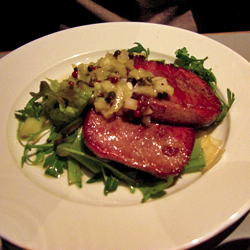 Even in the foodie heaven that is San Francisco, there’s no place like Konstam at the Prince Albert. A Victorian pub that’s been converted to a high-design jewelbox restaurant — it would take an entire paragraph just to explain the chandeliers-slash-draperies — Konstam toes the eat-local line with none of the obfuscation inherent in the standard “….whenever possible” disclaimer of Bay Area menus.
Even in the foodie heaven that is San Francisco, there’s no place like Konstam at the Prince Albert. A Victorian pub that’s been converted to a high-design jewelbox restaurant — it would take an entire paragraph just to explain the chandeliers-slash-draperies — Konstam toes the eat-local line with none of the obfuscation inherent in the standard “….whenever possible” disclaimer of Bay Area menus.
Even more impressively, Konstam’s sourcing radius is dramatically smaller than the usual 100-mile American definition: 85% of the kitchen’s ingredients, including flour and protein, come from the area covered by the London Underground and/or bounded by the M25 beltway, depending on where you’re reading. Either way, we’re talking about more or less 25 miles from central London.
One more thing: It seems that the idea to source ingredients locally was written into the restaurant’s plan before Chef Oliver Rowe really knew it was possible — but after a television deal had been signed. As a result, his tiny temple to seasonal and local food was well-known to British foodies even before the first meal was served. A two-week BBC miniseries called The Urban Chef documented the trials and tribulations of opening Konstam and finding suppliers. Watching video of Chef Rowe scouring the outer reaches of London feels like nothing so much as a giant, £300,000 dare… with the entire country watching each night on the telly.
 But enough about the schtick: How’s the food? Rowe wisely chose Northern and Central Europe as his inspiration, so even in the dead of an English winter, there’s sense to be made of the menu. A bowl of celeriac and apple soup came scattered with abundant hazelnuts, chunks of blue cheese, and a sprinkling of dill; the portion was far too large for such a dense porridge, but the flavors were lovely. Cameron enjoyed a starter of grilled Sevenoaks ox tongue, perfectly buttery-soft but meaty, garnished with a piquant pickled peppercorn relish atop a slick leek salad. It’s hard to choose which of our mains was the winner: Cameron chose perfectly charcoal-grilled leg of mutton, served with intensely vegetal chard and comforting colcannon. My own moan-inducing roast pork belly — complete with scored crispy crackling — came with both picture-perfect roast potatoes and a too-sweet cabbage compote.
But enough about the schtick: How’s the food? Rowe wisely chose Northern and Central Europe as his inspiration, so even in the dead of an English winter, there’s sense to be made of the menu. A bowl of celeriac and apple soup came scattered with abundant hazelnuts, chunks of blue cheese, and a sprinkling of dill; the portion was far too large for such a dense porridge, but the flavors were lovely. Cameron enjoyed a starter of grilled Sevenoaks ox tongue, perfectly buttery-soft but meaty, garnished with a piquant pickled peppercorn relish atop a slick leek salad. It’s hard to choose which of our mains was the winner: Cameron chose perfectly charcoal-grilled leg of mutton, served with intensely vegetal chard and comforting colcannon. My own moan-inducing roast pork belly — complete with scored crispy crackling — came with both picture-perfect roast potatoes and a too-sweet cabbage compote.
Although the wine list includes mostly Continental offerings, you can opt for a well-balanced choice of English wines from Kent, about 60 miles away, or pick from a great assortment of local ciders and ales from artisanal producers. We sampled the Sauvignon Blanc-like Chapel Down white and the funky Burrow Hill extra-dry cider; neither required the expected “pretty nice… for a local product” caveats.
Dessert was a modern take on traditional Victoria sponge — cake layered with cream and preserves — drizzled with vanilla syrup. Simple and exceedingly sweet, it would have been lovely with the espresso we ordered, but never received. And on that note: London will never be known for its stellar table service, but Konstam’s was even a step below the usual indifference. We were so happy with our food that we weren’t too troubled, but I can conjur a mood where we would have been furious at all the many issues with poor pacing, forgotten items, and long stretches of time where waitstaff simply disappeared — no mean feat in a restaurant the size of a large living room.
You could imagine Konstam being a worthwhile destination simply as a curiosity, a stunt-piece of a restaurant built on a conceit that might age poorly. But even without its locavore angle, the food delivers without offering (or requiring) any apologies for its constraints.


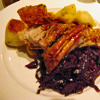


Konstam at the Prince Albert
2 Acton Street
London, WC1X 9NA
020 7833 5040
Dark Days challenge, locavore, London, restaurants
1 Comment »




Posted by Anita on 12.25.08 1:20 AM
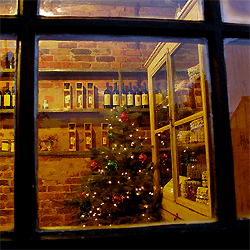 Happy Christmas, that is, from jolly old England! We’re having a blast on our vacation so far, eating lots of tasty food (fish & chips twice so far, both excellent), drinking pints of bitter in some gorgeous pubs, shopping at Borough Market, visiting with friends, and generally feeling very lucky to be in London at Christmas.
Happy Christmas, that is, from jolly old England! We’re having a blast on our vacation so far, eating lots of tasty food (fish & chips twice so far, both excellent), drinking pints of bitter in some gorgeous pubs, shopping at Borough Market, visiting with friends, and generally feeling very lucky to be in London at Christmas.
Speaking of luck: Don’t forget that today is the last day to bid on Menu For Hope raffle prizes. (Edited to add: The deadline’s been extended to 12/31!) If you have your heart set on winning our Ferry Plaza gourmet gift basket, the odds are still very promising. Be sure to check out Pim’s page for updates and new prizes that have been added along the way. There’s some good stuff in there that I’m sure someone on your last-minute present list would love to have a chance to win.
May your days be merry and bright!
holidays & occasions, London, Menu for Hope
3 Comments »




Posted by Anita on 12.23.08 3:27 AM
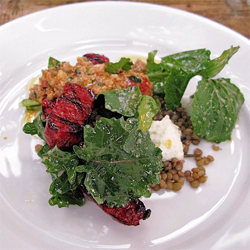 Here’s a recipe for a magical midwinter’s afternoon: Take the Tube to Richmond, a village on the fringes of London, then hop a red double-decker bus for a ride along the Thames. Alight in front of the cheery half-timbered pub, walk down the church lane past the Celtic stone crosses, left at the split-rail fence, and bob’s your uncle: You’ve arrived at Petersham Nurseries.
Here’s a recipe for a magical midwinter’s afternoon: Take the Tube to Richmond, a village on the fringes of London, then hop a red double-decker bus for a ride along the Thames. Alight in front of the cheery half-timbered pub, walk down the church lane past the Celtic stone crosses, left at the split-rail fence, and bob’s your uncle: You’ve arrived at Petersham Nurseries.
Now, even if an afternoon at a garden centre is not your idea of holiday time well spent, bear with me. Remember that the English excel at creating magical places, at planting beautiful gardens, at the eternal joy that is lunchtime. So it should come as no surprise that a mid-day repast inside a converted greenhouse — complete with dirt floors, mismatched chairs, and waitresses wearing muckboots with skirts — would be just the sort of adventure that would pay off very handsomely indeed.
Take your seat under the heater, and start with the seasonal sparkler — say, vanilla-rhubarb prosecco — then pick an appetizer to share. (If the chorizo starter with with lentils, caprini fresca, and agresto is on the menu, please order it; you won’t be sorry.) Pick your mains from a short list, one of which always seems to be vegetarian and another fish. Chef Skye Gyngell’s team “sources the best-quality seasonal ingredients that we can lay our hands on”, so you might opt for a whole roasted partridge with farro, chard, and salsa verde, or perhaps a fillet of sea bass served with clams, fino, arrocina beans, and aioli. Make sure to save room for dessert: The hazlenut tart comes with a generous drizzle of chocolate sauce and a dollop of airy crême fraiche.
Should you need to freshen up, you’ll find the loos in the hobbit-like wooden structure that houses the cafe kitchen and the teahouse. The latter — if you’ve neglected to book ahead, or just fancy a lighter nosh — offers a daily soup served with good bread and a hodgepodge of sweet cakes. And tea, of course. Always tea.
The nursery yard itself is full of all sorts of treasures, so if you’re a gardening buff — or, really, even if you aren’t — be sure to budget enough time to stroll and browse. The last lunch reservation is taken at 2:45, but the retail side remains open until 5pm, although in the dwindling light of wintertime you might plan to come early rather than stay late.
Bundle up and stroll back down the lane to the bus stop, where the diamond-paned windows of the pub now glow with holiday cheer. Your bus will be along promptly — this is England, after all — ready to whisk you back up the hill to Richmond and the real world… full, happy, and content.





Petersham Nurseries & Cafe
Church Lane, off Petersham Road
Richmond
Surrey TW10 7AG
020 8940 5230
garden, locavore, London, lunch, restaurants, travel
3 Comments »




Posted by Anita on 12.20.08 3:16 PM
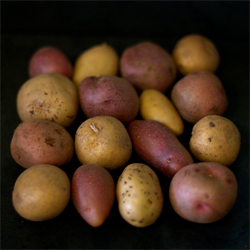 At our company Christmas party on Thursday night, the subject turned — as it often does in my culinary-obsessed office — to food. My boss’s husband asked me an interesting ice-breaker question: ‘What is your absolute favorite food?’
At our company Christmas party on Thursday night, the subject turned — as it often does in my culinary-obsessed office — to food. My boss’s husband asked me an interesting ice-breaker question: ‘What is your absolute favorite food?’
‘Easy,’ I replied immediately, ‘Potatoes, no questions asked.’
He was a little taken aback by my prompt reply; apparently, usually people hem and haw, then pick two or three favorites. But not me. I’m a potato girl to the end, and the only food that even comes close is pork. But it’s still second.
The quizzing continued, and I allowed as though I’d happily eat potatoes in any of their guises — boiled, hash-browned, french-fried, scalloped — but that my favorite-of-favorites had to be a big baked potato with butter and chives, salt & pepper.
About the only way I don’t like potatoes is the way they happen to be served at nearly every breakfast joint in San Francisco: Nominally home-fries, they’re irregularly shaped potatoes cooked on a giant flat-top griddle until they’re watery inside and burnt to a char on the out. They’re so universally terrible (and so terribly universal) that unless I know a restaurant serves shredded-style hash browns, I’ll ask for something else as a side-order substitute.
 Of course, any recipe with the word ‘home’ right in its name really begs to be made at one’s own stove, preferably while wearing pyjamas. And that’s just what I did when it came time to clean out the larder before our trip to London.
Of course, any recipe with the word ‘home’ right in its name really begs to be made at one’s own stove, preferably while wearing pyjamas. And that’s just what I did when it came time to clean out the larder before our trip to London.
We’d cider-brined a Range Brothers pork chop, and served it with O’Brien Potatoes, a sort of jumped-up version of home-fries recipe that, not-so-coincidentally, helped us use up a basket of new potatoes, a handful of tiny piquillo peppers, and a set of tiny onions, all in one fell swoop. Cameron seared the chop and then finished it in the oven, which gave him an excellent starting point for a sumptuous pan sauce (which used up the other half of the cider bottle, along with a little bit of chicken stock an a pat of butter. It was such a perfect accompaniment for the potatoes, they needed nothing more.
And as fridge clean-out meals go, it was a feast fit for a king.
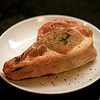
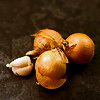
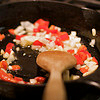

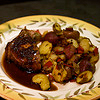
Potatoes O’Brien
12 to 16 baby potatoes
1 small onion, diced
2 piquillo peppers, or 1 small red bell pepper, diced
1 clove garlic, sliced
oil or bacon drippings
parsley, for garnish
Boil the potatoes until tender but still firm, a few minutes less than you would for potato salad. Meanwhile, saute the pepper and onion over medium-low heat in a wide skilled with sufficient oil or fat to soften well; back off on the heat if they begin to brown. When the potatoes are done, drain and rinse in cold water. As soon as they are cooled off enough to handle, slice into wedges or wide slices. Add the garlic to the saute mixture, and cook for 1-2 minutes to begin softening. Add the potato slices, and stir to coat; you may need to add more fat at this point if you weren’t generous with it at the beginning. Keep the heat on low, cooking the mixture together. Stir occasionally to check for sticking, but as little as possible to keep the potatoes intact and help with browning. When your main dish is almost ready, turn up the heat to medium or medium-high, and brown the potatoes to your liking, stirring once or twice to brown well on all sides. Season to taste with salt and pepper — if you used bacon fat, you won’t need much — and serve with sour cream, pan gravy, or ketchup.
Dark Days challenge, locavore
4 Comments »




Posted by Cameron on 12.16.08 1:46 PM
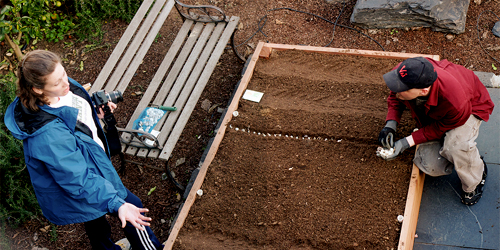
I have never been an instinctively organized person. I tend to leave planning until the last minute, overestimate (and overbuy) the necessary materials, and then fly by the seat of my pants. Most of the time my “method” works, but it can be wasteful. It’s also hard to define and evaluate what I did in retrospect, so that I can do it better next time.
I have been trying like heck not to take my typical approach with our nascent vegetable garden. From the construction of our new raised beds (hammer and shovel account coming in a future post, I promise) to planning plantings, I have actively encouraged my inner project manager to come out and play.
However, I am acutely aware of the fact that what I consider a “plan” often sounds like Marty McFly’s instructions to the 1950s dance band in Back to the Future: “Okay guys, this is a blues riff in B. Watch me for changes and try and keep up, okay?” So when Genie, aka the Inadvertent Gardener, volunteered to lend a hand with our very first planting, I was primed to overthink the entire event. And boy, did I.
I read all of the instructions on the seed packets, inside and out, cross-referencing the information with my two new best friends, Pam Peirce’s Golden Gate Gardening and Jeff Ball’s 60-Minute Vegetable Garden. I gazed at our new beds, making calculations about relative amounts of sun and shade, and searched the Web for general planting instructions, raised bed ideas, and wide-row planting theory. I made a list of the vegetables that I wanted to grow, organized by the distance between rows that each required. I drew up a small diagram of my beds (to scale, of course), illustrating what would go where. And, when Genie asked what time she should arrive on Saturday, I thought about how much time planting might take and left a generous margin for error, suggesting that I pick her up from the BART station at 1pm.
Saturday morning, I laid out all of my garden tools (a shovel, a long rake, a hand trowel, and a hand rake) and the seed packets, clipped together. It wasn’t until Genie arrived and I started describing the work plan — illustrated with my hyperactive little meth-junkie diagram — that I started hearing the loose screws rattling around in my tiny little head. I hauled in the reins and ground to a halt, biting off the suggestion that we measure the distance between rows. Folks, we’re talking about two small raised beds, each almost exactly eight feet long and four feet wide; surrounded by and aligned with stone tiles that are each almost exactly two feet square. About the only thing that we didn’t have to work with was a grid printed directly on the dirt. Somewhat sheepishly, I handed Genie a rake and suggested that we start loosening the soil in the beds, which had settled and crusted over a bit in the two weeks since I installed them.
About an hour later, I was feeling like an even bigger dork. The planting that I thought would take most of the afternoon? Done. Actually, Genie finished her bed in about 30 minutes and spent the rest of the time taking pictures of me stumbling about. Right now, somewhere, my über-gardener mom is looking down on me and laughing her butt off. With love, sure. But laughing nonetheless.
But you know what? We now have a bunch of dirt with seeds in it! We’ve got three kinds of onions in (two from seed and one from sets) — some that I’m planning to pull as scallions. We also planted three rows of mixed beets, two rows of French breakfast radishes and another of cherry radishes, a row of leeks, two of peas, and one of mixed lettuce.
And to tell the truth, I could use more “chore” days like this one. Anita made delicious lunch of Reuben sandwiches with Marin Sun Farms pastrami, which we ate with Laura’s dilly beans and Sean’s pickles. We spent the rest of the afternoon talking, playing with the pups, sipping beer, and kibitzing in the kitchen.
After the sun went down, the three of us washed our faces, put on our city duds, and headed off to SPQR, where red wine, non-stop wisecracks, at least six different kinds of pork, and a surprise fireworks display (seen across the bay from the top of Fillmore Street as we waited for our table) were the order of the evening. If there’s a better, happier, more karmically charged way to kick off a new garden, I cannot imagine what it would be.



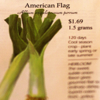

garden, other blogs
11 Comments »




Posted by Anita on 12.15.08 10:54 PM
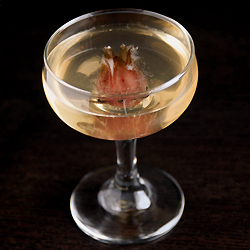 When Sean and DPaul asked me to contribute a signature cocktail to serve with the appetizer course at their holiday soirée last weekend, I kept running into dead ends. For my previous stint behind the Hedonia bar, I’d whipped up a pair of well-received drinks, but for the holidays I wanted to try something a little more classically festive — and what’s more festive than bubbly?
When Sean and DPaul asked me to contribute a signature cocktail to serve with the appetizer course at their holiday soirée last weekend, I kept running into dead ends. For my previous stint behind the Hedonia bar, I’d whipped up a pair of well-received drinks, but for the holidays I wanted to try something a little more classically festive — and what’s more festive than bubbly?
But, if you know those Hedonia boys, you know that their parties are a feast for the eyes as well as the palate; a simple Champagne cocktail — classic though it may be — would not do. No, I needed a conversation starter, a ‘wow’ of a drink that would be sure to set off the beautiful hors d’oeuvres. I toyed with a number of ideas, but kept coming back to the idea of poinsettias and other holiday flowers. Then, while digging through the liquor cabinet, I noticed a jar of candied hibiscus flowers: pretty, festive, and a perfect holiday red.
The purveyor of these little antipodean garnishes suggests dropping one blossom into a flute of bubbly, with or without a splash of its syrup. But even before I remembered Craig‘s choice for this month’s Mixology Monday theme, I knew that I wanted to avoid fruity flavors and move things more into the spice realm.
At first, I tried a simple Champagne and Ginger cocktail, using Domaine de Canton ginger liqueur. Although sweet and pleasant, it really didn’t have the oomph I was looking for. A few hearty dashes of super-spicy whiskey barrel-aged bitters helped a bit, but really didn’t carry the drink into fabulousness.
Then I remembered an experiment from two winters ago. In the days before Domain de Canton hit the shelves, I’d spent a few months trying different techniques to get a strong ginger flavor into a cocktail without using ginger beer, mostly unsuccessfully. But then a “so simple it couldn’t work” idea paid off, and I ended up with a batch of spicy, faintly sweet infusion with a true ginger flavor. A repeat batch of this crystallized ginger digestif turned out to be just the thing to make my holiday sparkler shine.
But back to the garnish: I sampled some of the syrup the blossoms were preserved in, so I had a good handle on their flavor. However, the jar of flowers only held 11 blossoms and I had 10 guests to serve, so I hoarded them all for party night. Little did I know that, instead of the pretty little flowers shown in all the marketing shots, the blooms would become translucent red aliens in the cocktail glass, wicked half-plant/half-animal mutants straight out of a sci-fi movie.
Luckily our hosts and friends were gracious enough to humor our cocktail folly; only one guest refused (vehemently, I might add) to sample the flower, which does indeed taste like a sweet-tart berry. And once the bizarre garnish was gobbled up, everyone asked for refills on their spicy Champagne.
Looking through the photos that DPaul graciously sent over (I managed to bring my camera, but forgot the memory card), I realized that the hibiscus blossom looks like the head of a snake, or a sandworm from the movie version of Dune… a story that’s — appropriately enough — all about spice.

Shai Hulud
1 oz homemade ginger liqueur
– or 1 oz Domaine de Canton plus 1/2 tsp ginger juice
5 dashes Fee Brothers Whiskey Barrel-Aged bitters
Champagne or other dry sparkling wine
candied hibiscus flowers
Measure the ginger liqueur and bitters into a coupe. Top with bubbly and garnish with a hibiscus flower.
Ginger Liqueur
3 oz crystallized ginger chunks
– available in the baking aisle or bulk foods stores
8 oz 80-proof vodka
Combine in a lidded jar. Let steep for two days, then shake; you should notice dark, syrupy threads diluting into the vodka. Continue to steep, shaking once a day, until you reach your desired level of spiciness.
drinks, Mixology Monday, recipes
8 Comments »




Posted by Anita on 12.15.08 7:00 AM
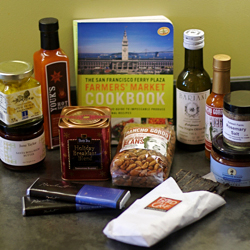 For two weeks every December, bloggers from all over the world offer a delectable array of food-related prizes for the Menu for Hope raffle. Last year, we raised $85,493 to help the UN World Food Programme feed the hungry. This year’s campaign runs December 15 to 25, and every $10 you donate earns you one virtual raffle ticket for the prize of your choice.
For two weeks every December, bloggers from all over the world offer a delectable array of food-related prizes for the Menu for Hope raffle. Last year, we raised $85,493 to help the UN World Food Programme feed the hungry. This year’s campaign runs December 15 to 25, and every $10 you donate earns you one virtual raffle ticket for the prize of your choice.
(To learn more, head over to Chez Pim and check out her Menu for Hope V FAQ, or read the highlights at the bottom of this post.)
This year, we’ve decided to reprise our most-popular offering from last year’s raffle:
Married …with Dinner’s signature “Best of the Ferry Building” gift basket
Prize code UW-07, a hand-picked assortment of our favorite treats — worth more than $125 — from San Francisco’s legendary Ferry Building Marketplace:
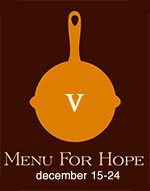 – Truffled artichoke tapenade from Lulu Petite
– Truffled artichoke tapenade from Lulu Petite
– Santa Rosa plum preserves from June Taylor
– Youk’s Sauce from Prather Ranch
– Holiday Breakfast Blend tea from Peet’s
– A pair of artisan “dark milk chocolate” bars from Recchiuti
– Ojo de Tigre beans from Rancho Gordo
– Rio Fuego “Very Hot Sauce” from Rancho Gordo
– Extra-virgin olive oil from Bariani
– Rosemary salt from Eatwell Farm
– Bittersweet chocolate ganache from Scharffen Berger
– Beef jerky from Fatted Calf Charcuterie
– A copy of the Ferry Plaza Farmers Market Cookbook
To give you something to remember us by when all the goodies are gone, this prize also includes the winner’s choice of an 8×10 print from our collection of market photos.
For our prize, international bids are welcome, but winners outside the Continental US will be asked to pay for any import duties and/or shipping fees over US$25.
—-
Here’s how to donate and get a chance to win:
- Check out the cool items available on Matt*Bites and Chez Pim. (We know you want to win OUR prize, but you might want to bid on others, too …you generous foodie, you.)
- Go to the donation page for Menu for Hope V. Just like last year, funds raised will go to support the United Nations World Food Programme.
- Make a donation! Each $10 you donate will give you one virtual raffle ticket toward a prize of your choice. Please specify which prize or prizes you’d like in the “Personal Message” section in the donation form when confirming your donation
- Don’t forget to mention how many tickets you want to allot per prize, and please use the prize code — for example, a donation of $50 can buy 1 ticket for UW-07, 1 for UW-08, and 3 for UW-09.
- If your company matches your charity donations, please remember to check the appropriate box on your submission and fill in the information so Menu for Hope can claim the corporate match.
- Please also check the box that allows the contest administrators to see your email address so that they can contact you in case you win. Your email address will not be shared with anyone else.
- Check back on Chez Pim on January 12, when Pim will announce the result of the entire raffle. (We’ll also announce the winner of our prize here.)
Good luck to everyone, and thanks for supporting such a worthy cause!
Menu for Hope
3 Comments »




Posted by Anita on 12.14.08 10:39 AM
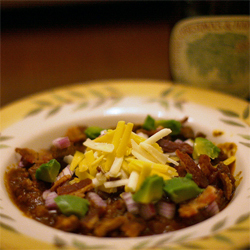 Between finishing up our Christmas shopping, getting our prize basket ready for Menu for Hope V, dealing with a rather scary veterinary emergency, and nailing down a few last details for our upcoming vacation, things have been a little chaotic around here. This morning as I sat down to write, I looked up in panic and realized that I had only photographed a single meal this week.
Between finishing up our Christmas shopping, getting our prize basket ready for Menu for Hope V, dealing with a rather scary veterinary emergency, and nailing down a few last details for our upcoming vacation, things have been a little chaotic around here. This morning as I sat down to write, I looked up in panic and realized that I had only photographed a single meal this week.
Luckily, it was our favorite chili, which — even though we eat it pretty much all the time — I’ve never blogged about. We love it because, unlike other chili recipes that we’ve been known to make, this one’s highly adaptable. Like our bolognese sauce and sloppy joes, it’s another one of the recipes that we make in giant batches and freeze for weeknight dinners. If we’re using it to make chilidogs — which we often do — we’ll leave the beans out and simmer it down until it’s all meaty and thick. If we’re eating it on its own, we’ll add some Rancho Gordo beans, and thin it down a little with a few cubes of frozen chicken stock.
We almost always garnish it with cheese, sour cream, and chopped onions, but if you happen to be lucky enough to have a strip of crispy bacon or a late-season avocado lurking in your fridge, either one makes a tasty and pretty addition. But this chili’s equally delicious when served all on its own, preferably with a pan of homemade cornbread and sweet butter. (We just discovered that Giustos, the local outfit that makes the all-purpose flour we buy, also sells locally milled cornmeal and polenta, which increases our Dark Days meal options significantly.)
 Adaptable Chili
Adaptable Chili
– loosely inspired by ‘Venison Chile with Red Beans’
from Staff Meals at Chanterelle
3 pounds stew meat, cut into 1/2-in inch cubes
(or substitute coarse-ground beef)
1 medium onion, diced
2 large cloves garlic, minces
1 tsp ground ancho chile
1 tsp ground pasilla chile
1 tsp Rancho Gordo ground red chile
1 tsp ground cumin
1 tsp ground cinnamon
1 tsp cayenne pepper
1/2 tsp black pepper
1/2 tsp dried thyme
1/2 tsp dried oregano
1/2 tsp cocoa powder
2 bay leaves
4 cups chicken stock or unsalted broth
1/2 cup tomato puree
2 cups cooked heirloom beans, drained (see note)
shredded cheese, sour cream, chopped onion, bacon, and/or diced avocado, for garnish
Pour vegetable oil to a depth of 1/8 inch into a large heavy Dutch oven set over medium-high heat. When the oil just begins to smoke, add only enough meat to cover the bottom of the pan without crowding. Brown well on all sides, turning with tongs. As the pieces brown, transfer to a bowl and continue with more meat in batches.
When meat is all browned, reduce heat to medium-low. Drain the accumulated oil from the bowl back into the pan; add the onion and garlic, and sweat until transluscent. Return the browned meat to the pan, then add the chile powders and spices. Stir well to coat the mat, then add the stock, tomato, and salt to taste. Bring to a boil, then reduce heat to low and simmer, uncovered, until the meat is tender — 2 to 2-1/2 hours — stirring occasionally. Stir in the beans, if using, and cook until heated through, about 5 minutes. Taste and adjust seasonings.
Note: If freezing for later use, the chili takes up less space without the beans, which you can always add the night you plan to serve it.
Dark Days challenge, locavore, recipes
8 Comments »




Posted by Anita on 12.07.08 2:26 PM
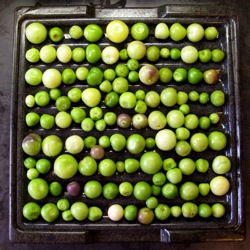 Last weekend, I went through both freezers — the little one in the kitchen, and the slightly larger one in the garage — and inventoried their contents. I didn’t discover any huge surprises in either location, thankfully, but I did turn up a few odds and ends that would be better to eat now rather than later. And since we needed to make room for half a turkey’s worth of meat, a little reorganization was in order.
Last weekend, I went through both freezers — the little one in the kitchen, and the slightly larger one in the garage — and inventoried their contents. I didn’t discover any huge surprises in either location, thankfully, but I did turn up a few odds and ends that would be better to eat now rather than later. And since we needed to make room for half a turkey’s worth of meat, a little reorganization was in order.
In addition to the pickles and broth I put up last weekend, I also made a big batch of tomatillo-sauce base to freeze: I roast and puree chiles and tomatillos, then add onions and simmer it down. Right before I’d usually add poultry broth and re-reduce to make a sauce, I cool down the paste and portion it out for the freezer. When I want to make enchiladas or chile verde, I thaw a brick, add the missing liquid, and finish the recipe.
 The two big Dark Days meals we cooked at home took care of some freezer odds and ends, and used the last of the un-frozen Thanksgiving leftovers, too. On Monday night, we whipped up a batch of our favorite stacked enchiladas with a little of the tomatillo sauce I’d set aside, along with a half-packet of tortillas and container of Rancho Gordo beans from the freezer, and the last bits of meat left over from turkey sandwiches. Later in the week, Cameron made a delicious beef-and-ale stew using a pound of Marin Sun chuck we’d stashed away from an early CSA box. Topped with the last of the Thanksgiving mashed potatoes, the stewmade a very decadent sort of cottage pie.
The two big Dark Days meals we cooked at home took care of some freezer odds and ends, and used the last of the un-frozen Thanksgiving leftovers, too. On Monday night, we whipped up a batch of our favorite stacked enchiladas with a little of the tomatillo sauce I’d set aside, along with a half-packet of tortillas and container of Rancho Gordo beans from the freezer, and the last bits of meat left over from turkey sandwiches. Later in the week, Cameron made a delicious beef-and-ale stew using a pound of Marin Sun chuck we’d stashed away from an early CSA box. Topped with the last of the Thanksgiving mashed potatoes, the stewmade a very decadent sort of cottage pie.
We spent some time this weekend getting the garden ready for fall, pruning the fruit trees and cutting back the hardy herbs like rosemary. I ended up with enough cuttings to make a few rustic wreathes. Contrary to my romantic notions, wreath-making can be a messy, sticky job (your hands end up covered in a pine-like sap!) but I think the end result was worth it. I now have pretty holiday decorations with a lovely scent, and afterward the sprigs can be stripped to use in cooking.


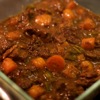

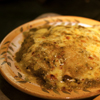
Where’s the recipe??
We’re experiencing some technical difficulties — our blog server is running painfully slow, and it was all we could manage to get this post up in time for the Dark Days roundup before running off to not one but two holiday parties this evening. If you’re interested in Cameron’s recipe for the Beef Braised in Ale, check back early next week.
Beef in Ale
– adapted from The River Cottage Meat Book
3# boneless chuck or stewing beef, trimmed and cut into 2-inch chunks
8 ounces pancetta or bacon, cut into 1-inch pieces
2 T butter or drippings
1 pound of onions (Hugh specifies baby onions, peeled and left whole. I used medium-sized yellow onions, quartered)
Up to 1/3 c all-purpose flour, seasoned with salt and pepper
4 cups ale (Hugh calls for stout)
2 bay leaves
1 sprig thyme
A few stems of parsley
8 ounces each of carrots and celery, cut into chunks
Heat the butter or drippings in a Dutch oven or other large stew pot and render the pancetta or bacon over medium heat, cooking until well-browned. Remove the bacon with tongs or slotted spoon and reserve on a plate. Fry the onions in the hot fat until they are lightly browned all over. Remove the onions and add to the bacon on the reserve plate. Turn up the heat to medium-high or high depending on your stove. Toss the beef in the seasoned flour and shake/pat off as much of the excess as possible, leaving only a fine layer of flour behind.
Working in batches, thoroughly brown the beef on all sides, removing it to the reserve plate when you dare not leave it in any longer. Here is where your diligence in flour removal will pay off. The browner you can make the beef chunks, the better your stew will taste, but extra flour will flake off and burn before you can get the beef where you want it.
Pour in some of the ale and deglaze the pot, scraping up the browned bits with a wooden spoon. Tip the contents of the reserve plate (bacon, onion, beef, and any juices that have collected) into the pot. Pour in the rest of the ale, adding water if necessary to just cover the meat. Add the herbs, tied into a bouquet garni. Taste and season lightly with salt and pepper, keeping in mind the saltiness of your bacon and the fact that you will be reducing the liquid. Bring to a boil and set to simmer gently with the lid on but slightly ajar.
The stew will need to cook roughly 2-1/2 hours. This can be done either on the stovetop or in an oven set to 250° F. If the meat starts to get exposed, add a little hot water. Approximately one hour before you expect the meat to be done, add the carrots and celery. You’ll know it’s done when the meat falls apart at the touch of a fork.
Remove the bouquet garni. Taste again for seasoning and serve under, over, beside, or puddled in potatoes that have been mashed with scandalous amounts of cream and butter.
Dark Days challenge, garden, locavore, recipes
8 Comments »




Posted by Anita on 12.06.08 9:03 AM
 When Cameron and I started blogging a few years ago, we were talking to ourselves. After walking away from the food message boards that had been our online home, we found ourselves adrift. A pair of food-obsessed writers can’t exist in a vacuum for long, so when our pal Sean suggested we should blog, it didn’t take us long to see the wisdom of his plan. We set up an account, bought a domain, and started writing.
When Cameron and I started blogging a few years ago, we were talking to ourselves. After walking away from the food message boards that had been our online home, we found ourselves adrift. A pair of food-obsessed writers can’t exist in a vacuum for long, so when our pal Sean suggested we should blog, it didn’t take us long to see the wisdom of his plan. We set up an account, bought a domain, and started writing.
An interesting thing happened along the way: People — strangers who we didn’t even know! — started reading the blog. Some of them even left us comments. And then we started visiting their blogs, leaving comments, and becoming intertwined with their lives. We celebrated their joys, cheered on their triumphs, cried at their losses, and consoled them in their grief… and they did the same for us. It’s funny to say this about people who I’ve (mostly) never met in person, but I’m closer with some of my food-blog pals than I am with people I see every day. To an outsider, perhaps this sounds odd, even a little loney… but to me, it’s one of the big blessings in my life, this circle of support and affection that literally crosses the oceans.
The most fabulous things happen in this little world of ours. Last week, I got an email from Bron, telling me that she and Ilva were planning a big surprise for our mutual friend Barbara, who’s been struggling with the side-effects of chemotherapy. Would I help them send a virtual hug to Barbara this weekend, in the form of a recipe? Oh, absolutely!
To me, nothing says love and comfort better than a bowl of soup. I know that bowl full of beef and chile sounds far too spicy and rich for someone struggling with the nausea and unpleasantness of chemo, but in truth this dish is clean, light, and flavorful, with just a hint of sweet spice. The broth base is chicken, not beef, so the flavors of the sprouts and scallions come singing through. Ginger is known to help with nausea, and if you seed the Fresno chile — which is already mild — you’re left with just the clean, fruity flavor and none of the heat. And because the meat is cooked separately and then used as a topping, you can adjust portions for varying appetites. Barbara doesn’t enjoy the taste of cilantro, so we substituted a sprig of flat-leaf parsley for the garnish; it’s mostly just for a splash of color, so feel free to leave it out entirely.
So here’s a hug to Barbara, across the oceans and miles. I wish we could come by and bring you a bowl of soup in person, but for now we’ll slurp a bowl of gingery noodles and keep you in our hearts.



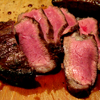
 Ginger Beef Ramen
Ginger Beef Ramen
– adapted from The Wagamama Cookbook
5 oz (150g) mung bean sprouts
9 oz (250g) ramen noodles
12 oz (350g) sirloin steak, 3/4-inch thick
teriyaki or soy sauce, for brushing
4 cups (1l) chicken stock
2T ginger, peeled and slivered, or more to taste
2T ramen sauce (recipe follows), plus more for serving
3 scallions, trimmed and sliced on the diagonal
1 red Fresno chile, trimmed, seeded, and sliced lengthwise
1/2 small red onion, sliced very thin
1 lime, quartered
parsley (or cilantro) sprigs for garnish
Rinse the steak and pat dry. Season with salt and brush with oil; let sit 30 minutes to come to room temperature.
Cook the noodles in a medium pot of boiling water until al dente, about 2 minutes. (I recommend cooking 1 minute less than the package indicates, as the hot soup will continue to cook the noodles later.) Drain and rinse with cold water until cool; drain well and set aside. In the same pot, heat the stock to a simmer; reduce heat to low and cover until ready to use.
Grill, broil, or pan-sear the steak until medium rare. Remove from the heat and immediately brush with teriyaki or soy sauce. Keep warm to rest for at least 5 minutes.
Add slivered ginger and 2T of ramen sauce to the stock, and heat to a rapid simmer; adjust for saltiness with soy sauce or fish sauce, as desired. Meanwhile, divide the noodles among two bowls, and slice the rested steak on the bias. Top the noodles with the beef, sprouts, scallions, chile slivers, onion. Garnish with herb sprigs and serve with lime wedges and additional sauce to add at the table.
Ramen Sauce
1 scant tsp sugar
1T malt vinegar
3T Asian sweet chile sauce (or to taste)
3T fish sauce
Dissolve the sugar in the vinegar, then combine with other ingredients.
cooking, other blogs, recipes
14 Comments »




 Even in the foodie heaven that is San Francisco, there’s no place like Konstam at the Prince Albert. A Victorian pub that’s been converted to a high-design jewelbox restaurant — it would take an entire paragraph just to explain the chandeliers-slash-draperies — Konstam toes the eat-local line with none of the obfuscation inherent in the standard “….whenever possible” disclaimer of Bay Area menus.
Even in the foodie heaven that is San Francisco, there’s no place like Konstam at the Prince Albert. A Victorian pub that’s been converted to a high-design jewelbox restaurant — it would take an entire paragraph just to explain the chandeliers-slash-draperies — Konstam toes the eat-local line with none of the obfuscation inherent in the standard “….whenever possible” disclaimer of Bay Area menus. But enough about the schtick: How’s the food? Rowe wisely chose Northern and Central Europe as his inspiration, so even in the dead of an English winter, there’s sense to be made of the menu. A bowl of celeriac and apple soup came scattered with abundant hazelnuts, chunks of blue cheese, and a sprinkling of dill; the portion was far too large for such a dense porridge, but the flavors were lovely. Cameron enjoyed a starter of grilled Sevenoaks ox tongue, perfectly buttery-soft but meaty, garnished with a piquant pickled peppercorn relish atop a slick leek salad. It’s hard to choose which of our mains was the winner: Cameron chose perfectly charcoal-grilled leg of mutton, served with intensely vegetal chard and comforting colcannon. My own moan-inducing roast pork belly — complete with scored crispy crackling — came with both picture-perfect roast potatoes and a too-sweet cabbage compote.
But enough about the schtick: How’s the food? Rowe wisely chose Northern and Central Europe as his inspiration, so even in the dead of an English winter, there’s sense to be made of the menu. A bowl of celeriac and apple soup came scattered with abundant hazelnuts, chunks of blue cheese, and a sprinkling of dill; the portion was far too large for such a dense porridge, but the flavors were lovely. Cameron enjoyed a starter of grilled Sevenoaks ox tongue, perfectly buttery-soft but meaty, garnished with a piquant pickled peppercorn relish atop a slick leek salad. It’s hard to choose which of our mains was the winner: Cameron chose perfectly charcoal-grilled leg of mutton, served with intensely vegetal chard and comforting colcannon. My own moan-inducing roast pork belly — complete with scored crispy crackling — came with both picture-perfect roast potatoes and a too-sweet cabbage compote.






























 – Truffled artichoke tapenade from Lulu Petite
– Truffled artichoke tapenade from Lulu Petite Between finishing up our Christmas shopping, getting
Between finishing up our Christmas shopping, getting 





 When Cameron and I started blogging a few years ago, we were talking to ourselves. After walking away from the food message boards that had been our online home, we found ourselves adrift. A pair of food-obsessed writers can’t exist in a vacuum for long, so when our pal
When Cameron and I started blogging a few years ago, we were talking to ourselves. After walking away from the food message boards that had been our online home, we found ourselves adrift. A pair of food-obsessed writers can’t exist in a vacuum for long, so when our pal 



 Ginger Beef Ramen
Ginger Beef Ramen